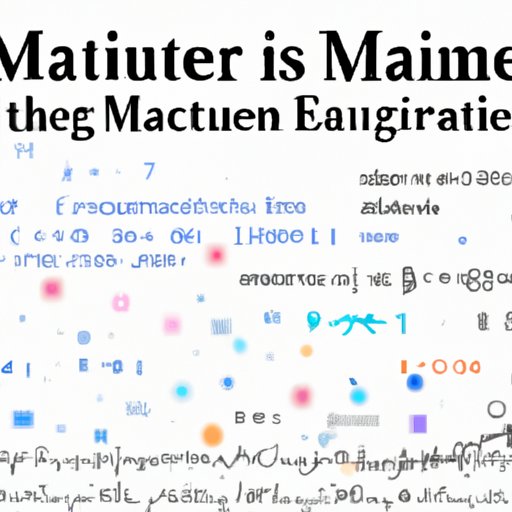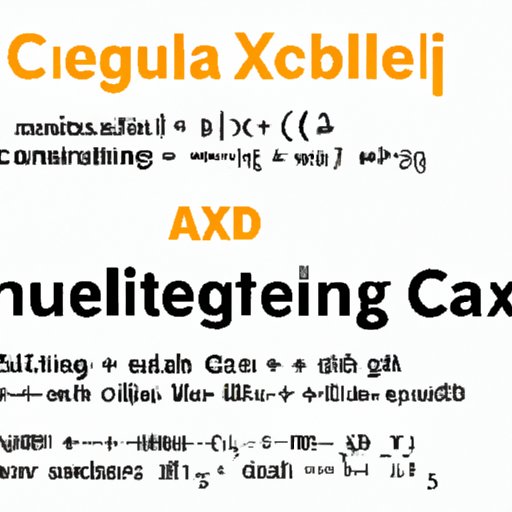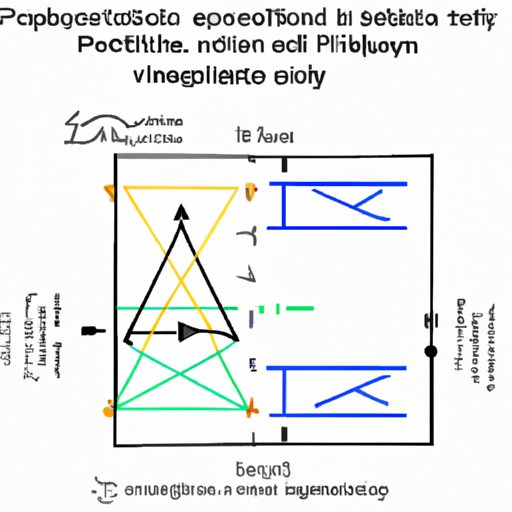Introduction
Data science is a rapidly growing field that uses advanced mathematics to analyze large data sets and extract meaningful insights from them. From predicting customer behavior to uncovering new trends, data science plays an important role in businesses and organizations of all sizes. But what kind of math do you need for data science?
In this comprehensive guide, we’ll explore the different types of math needed for data science and discuss how to use them in real-world applications. We’ll also provide an overview of the essential mathematics required for data science projects, including topics such as variables, functions, and data analysis techniques. By the end of this guide, you’ll have a better understanding of the math needed for data science and how to apply it to your own projects.

A Comprehensive Guide to Math for Data Science
The math needed for data science can be divided into several key categories: algebra, statistics, calculus, probability, linear algebra, and machine learning. Let’s take a closer look at each one.
Algebra
Algebra is the study of mathematical equations and their solutions. In data science, algebra is used to solve problems relating to data sets, such as calculating the mean or median of a set of numbers. Algebra is also used to manipulate data sets, such as by transforming data points into different formats or creating new equations based on existing data.
Statistics
Statistics is the study of collecting, analyzing, and interpreting data. In data science, statistics is used to identify patterns and trends in data sets, such as correlations between variables. It is also used to make predictions about future events, such as customer buying habits or stock market movements.
Calculus
Calculus is a branch of mathematics that studies the rate of change of functions and their derivatives. In data science, calculus is used to calculate the derivatives of data sets, which can then be used to determine the direction and magnitude of trends. Calculus is also used to estimate the probability of certain outcomes, such as the likelihood of success for a new product.
Probability
Probability is the study of the likelihood of certain outcomes occurring. In data science, probability is used to determine the chance of a certain event happening, such as whether a customer will purchase a particular product. Probability is also used to create predictive models, such as forecasting customer spending habits.
Linear Algebra
Linear algebra is the study of linear equations and linear transformations. In data science, linear algebra is used to solve systems of equations, such as those involving multiple variables. It is also used to construct matrices, which can be used to represent data sets and to perform calculations on them.
Machine Learning
Machine learning is a type of artificial intelligence (AI) that uses algorithms to learn from data. In data science, machine learning is used to make predictions and recommendations based on data sets. For example, machine learning can be used to predict customer behavior or recommend products to customers.

Exploring Essential Mathematics for Data Science
To understand the math needed for data science, it’s important to first explore the fundamentals of mathematics. This includes concepts such as variables, functions, and data types.
Understanding Variables and Functions
Variables are values that can change over time. In data science, variables are used to represent data points, such as customer age or purchase amount. Functions are equations that describe relationships between variables. In data science, functions are used to describe relationships between data points, such as the relationship between customer income and product purchases.
Exploring Different Types of Data
Data science involves working with different types of data, such as numerical, categorical, and temporal data. Numerical data consists of numbers, such as customer age or sales figures. Categorical data consists of categories, such as gender or product type. Temporal data consists of dates and times, such as when a customer made a purchase or when a product was released.
Manipulating and Analyzing Data
Data science involves manipulating and analyzing data sets. This includes tasks such as sorting data points, calculating averages, and plotting data points on graphs. It also involves using statistical methods to identify patterns and trends in data sets, such as correlations between variables.

From Algebra to Calculus: A Look at the Math Needed for Data Science
Now that we’ve explored the basics of mathematics, let’s take a closer look at the math needed for data science. This includes introducing different mathematical concepts, using mathematical models to solve problems, and leveraging mathematical knowledge in real-world applications.
Introducing Different Mathematical Concepts
Data science requires a good understanding of various mathematical concepts, such as algebra, calculus, and probability. It’s important to understand how these concepts work and how they can be used to solve data science problems. For example, understanding the basics of probability can help you identify trends in data sets or make predictions about future events.
Using Mathematical Models to Solve Problems
Data science involves using mathematical models to solve problems. These models can be used to identify patterns in data sets, make predictions, or generate simulations. For example, linear regression models can be used to identify correlations between variables, while neural networks can be used to make predictions based on data sets.
Leveraging Mathematical Knowledge in Real-World Applications
Once you have a good understanding of the math needed for data science, you can start to apply it to real-world applications. This includes tasks such as creating models to predict customer behavior, leveraging machine learning algorithms to make recommendations, and using statistical methods to identify trends in data sets.
Understanding the Role of Math in Data Science Projects
Math plays an essential role in data science projects. To successfully complete data science projects, it’s important to understand the math needed for data science and how to use it in real-world applications. Here are some tips for doing so:
Establishing Mathematical Foundations
Before starting a data science project, it’s important to establish a strong mathematical foundation. This includes understanding the basics of mathematics, such as algebra, calculus, and probability. It’s also important to understand the different types of data and how to manipulate and analyze them.
Creating Mathematical Models and Simulations
Once you have a good understanding of the math needed for data science, you can start to create mathematical models and simulations. This includes tasks such as building linear regression models to identify correlations between variables, or using machine learning algorithms to make predictions. It’s important to understand the limitations of these models and how to use them effectively.
Applying Mathematical Techniques to Analyze Data
Finally, it’s important to understand how to apply mathematical techniques to analyze data. This includes tasks such as using statistical methods to identify patterns and trends in data sets, or using probability to estimate the likelihood of certain outcomes. It’s also important to understand the implications of the results of these analyses.
Conclusion
Data science requires a broad range of mathematical skills, from algebra to calculus. Understanding the math needed for data science is essential for successfully completing data science projects. This guide has provided an overview of the different types of math needed for data science, as well as tips on how to use them in real-world applications.
By understanding the math needed for data science and how to leverage it in real-world applications, you can become a successful data scientist. With the right mathematical knowledge and skills, you can use data science to uncover meaningful insights and create powerful predictive models.
(Note: Is this article not meeting your expectations? Do you have knowledge or insights to share? Unlock new opportunities and expand your reach by joining our authors team. Click Registration to join us and share your expertise with our readers.)
